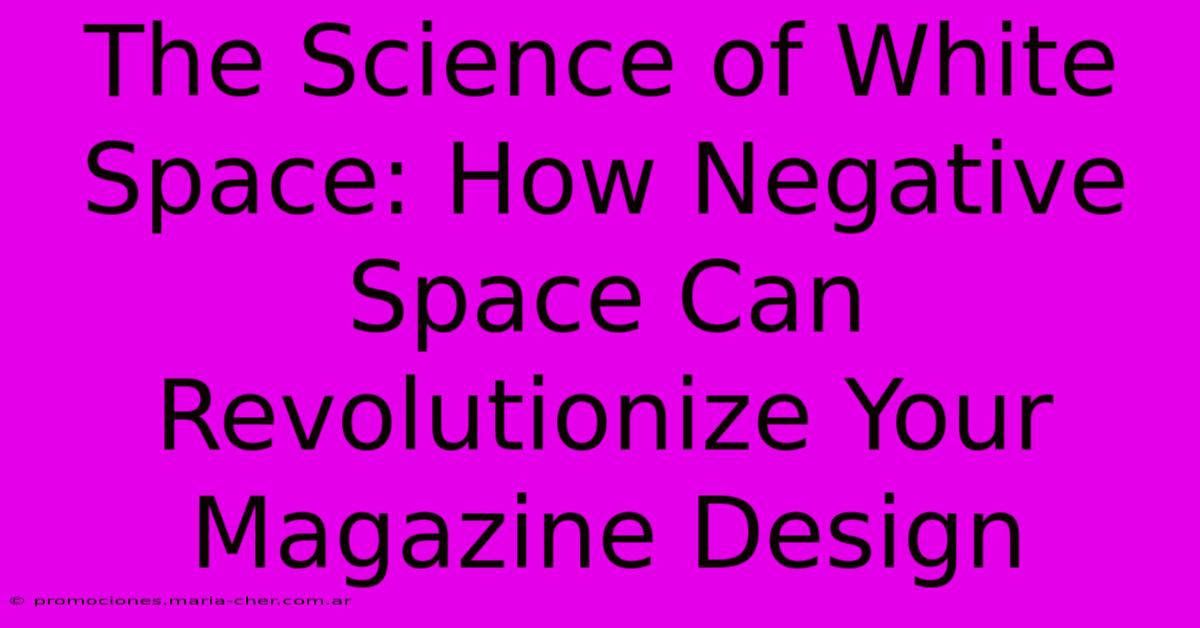The Science Of White Space: How Negative Space Can Revolutionize Your Magazine Design

Table of Contents
The Science of White Space: How Negative Space Can Revolutionize Your Magazine Design
In the bustling world of magazine design, where vibrant colors and captivating imagery reign supreme, it's easy to overlook the power of emptiness. But what if I told you that the strategic use of white space, or negative space, isn't just an aesthetic choice but a crucial element that can dramatically improve your magazine's readability, visual hierarchy, and overall impact? This article delves into the science behind white space and reveals how mastering negative space can revolutionize your magazine design.
Understanding the Power of Negative Space
White space, also known as negative space, is the area around and between the elements of your design—the "empty" space that isn't filled with text, images, or graphics. Contrary to popular belief, it's not about lack of design, but rather a powerful design element in its own right. It's the unsung hero that elevates your design from cluttered to clean, from confusing to compelling.
The Psychological Impact of White Space
Think of white space as breathing room for your reader's eyes. Overcrowded pages can lead to cognitive overload, making it difficult for readers to process information and potentially causing them to abandon your magazine altogether. Strategically placed white space:
- Improves Readability: It separates blocks of text, making it easier to scan and digest information.
- Enhances Visual Hierarchy: It guides the reader's eye, directing attention to key elements and creating a clear visual flow.
- Creates a Sense of Calm and Sophistication: A well-designed layout with ample white space conveys professionalism and elevates the perceived value of your publication.
- Boosts Brand Identity: Consistent use of white space strengthens your brand's visual identity, creating a recognizable and memorable aesthetic.
Mastering the Art of White Space in Magazine Design
The effective use of white space isn't simply about leaving random gaps on the page. It's a calculated approach that requires careful consideration of several key aspects:
1. Margins and Gutters: Establishing a Foundation
Adequate margins (the space around the edges of the page) and gutters (the space between columns) are fundamental to good design. They provide a visual breathing space and prevent the text from feeling cramped. Experiment with different margin sizes to find what best suits your magazine's style and content.
2. Spacing Between Elements: Creating Visual Breathing Room
Consistent spacing between headlines, subheadings, body text, images, and other design elements is essential. This creates a sense of visual rhythm and improves readability. Use consistent spacing throughout your magazine for a unified look and feel.
3. Strategic Use of White Space: Highlighting Key Elements
Use white space to emphasize important elements. For example, placing a large image in a sea of white space immediately draws the reader's eye. This technique is particularly effective for cover design and feature spreads.
4. Typography and White Space: A Harmonious Partnership
The choice of typeface and its relationship to white space are inextricably linked. A large font size with ample spacing creates a clean and modern feel, while smaller font sizes might necessitate more compact spacing. The balance between typography and whitespace is crucial.
Examples of Effective White Space Use in Magazine Design
Observe successful magazines like Kinfolk, Monocle, and The New Yorker. Notice how they use white space to create a sense of sophistication, elegance, and calm. Their design is minimalist, not empty. They skillfully employ white space to improve readability and guide the reader's eye, thereby improving the overall reading experience.
Conclusion: Embrace the Power of the Void
White space isn't just about empty space; it's a powerful design tool that can elevate your magazine's design to new heights. By understanding the science behind negative space and applying the principles outlined above, you can create a magazine that is not only visually appealing but also highly readable and engaging. Embrace the power of the void and watch your magazine design revolutionize itself. Remember that consistent application and a keen eye for balance are key to unlocking the full potential of white space. Experiment, iterate, and refine your approach to create a publication that truly stands out.

Thank you for visiting our website wich cover about The Science Of White Space: How Negative Space Can Revolutionize Your Magazine Design. We hope the information provided has been useful to you. Feel free to contact us if you have any questions or need further assistance. See you next time and dont miss to bookmark.
Featured Posts
-
Polaroid Sizes Unveiled From Petite To Panoramic Theres A Polaroid For Every Moment
Feb 08, 2025
-
Countdown To Christmas 6 Email Sequences To Enchant Your Subscribers
Feb 08, 2025
-
Unleash The Pink Perfection A Photographers Guide To Capturing Hot Pink Bridal Bouquets
Feb 08, 2025
-
Harness The Power Of Perspective Transform Ordinary Scenes Into Unforgettable Self Portraits
Feb 08, 2025
-
The Science Of White Space How Negative Space Can Revolutionize Your Magazine Design
Feb 08, 2025
